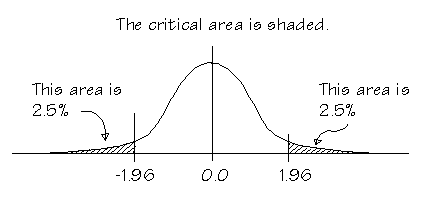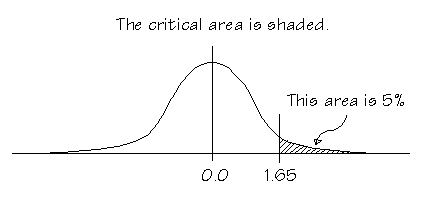![]()
![]()
1. Earphones and earplugs, Inc. wants to focus its marketing for a new compact disc player on young affluent professionals. Their marketing department identified two magazines, Wired Xers and Quiche & Volvo as being especially popular among their target population. The advertising department of Quiche & Volvo claims that the age of its average subscriber is not the same as the average subscriber of Wired Xers. Formulate a pair of research and null hypotheses to test this claim.
2. Would you be doing a 1-tailed test or a 2-tailed test?
Since the hypotheses are about the existence of a difference between the two means and not the direction of the difference, it would be a two-tailed test.
3. Determine the critical value for a 95% level of confidence (p<0.05).
The critical value for a 95% two-tailed test is ± 1.96.
4. Draw a normal curve, mark it with z values and ages, and shade the critical region.

Because it is a 2-tailed test, either a positive or a negative difference will be relevant.
5.The advertising department of Wired Xers argued that, in fact, its readers were younger than those of Quiche & Volvo. Formulate the research and null hypotheses needed to test this contention. Then determine the critical region for a level of significance of p< 0.05.
6. Would you be doing a 1-tailed test or a 2-tailed test?
Because the hypotheses contain reference to the direction of the difference, this one involves a 1-tailed test.
7. Determine the critical value for a 95% level of confidence (p<0.05).
If you are using the 95% confidence level, for a 2-tailed test you need a z below -1.96 or above 1.96 before you say the difference is significant. For a 1-tailed test, you need a z greater than 1.65. The critical value of z for this test will therefore be 1.65.
8. Draw a normal curve, mark it with z values and ages, and shade the critical region.

The difference is calculated by subtracting the mean age of Wired Xers readers from the mean age of Quiche & Volvo readers because the null hypothesis says that readers of Wited Xers are younger than readers of Quiche & Volvo and, if the null hypothesis is true, the difference calculated this way will be positive.
9. A random sample of size 24 was selected from individual subscribers to Wired Xers. The ages were as follows:
23 43 27 45 30 32 26 42 43 25 38 35
28 26 44 47 40 34 45 43 43 42 32 32
A similar sample was drawn for Quiche & Volvo:
29 28 49 45 47 35 34 45 49 53 36 44
30 36 34 42 43 26 33 46 37 47 48 35
Calculate the means and standard deviations. To help, I’ve calculated some sums for you. I’ve used “W” for Wired Xers and “Q” for Quiche & Volvo.
mean S.D. Quiche & Volvo 39.6250 7.7393 Weird Xers 36.0147 7.6867
10. Estimate the standard error of the mean for the population from which the Q&V sample was drawn.
11. Calculate the .95 and .99 confidence intervals about the mean for the Q&V sample.
For the 95% confidence interval, you multiply the standard error of the mean by 1.96 and then you subtract the result from the mean to get the lower limit and add the result to the mean to get the upper limit. The 95% confidence interval will thus be 39.6250 ± 1.96 × 1.5798 or 39.6250 ± 3.0964 or 36.5286 to 42.7214.
For the 99% confidence interval, you multiply the standard error of the mean by 2.58 and then you subtract the result from the mean to get the lower limit and add the result to the mean to get the upper limit. The 99% confidence interval will thus be 39.6250 ± 2.58 × 1.5798 or 39.6250 ± 4.0759 or 35.5491 to 43.7009.
12. Can you conclude that the readers of Q&V are older than the readers of W-Xers? Determine whether the difference between the sample means is statistically significant. Use .05 as your probability level. Be careful here. Draw a normal curve and label it appropriately and shade the critical region. Don't be misled by the last two questions.
Here are the hypotheses you would use:
Because the hypotheses are directed (they make reference to the direction of the difference), you would do a 1-tailed test. With the .05 probability level, the critical value of z is 1.65.
The difference between means will be calculated by subtracting the mean for W-Xers from the mean for Q&V so that, if the alternate hypothesis is true, the difference will be positive. The difference is:
39.6250 - 36.0147 = 3.6103.To turn the difference into a z, you have to divide it by the standard error of the difference between means:
But first, you need the standard error of the difference between means, which is estimated with this equation:
Now you can calculate z:
Since your value of z, 1.62147, is smaller than the critical value of 1.65, you fail to reject the null hypothesis. Therefore you must conclude that your data does not convince you that the readers of Q&V are older than the readers of W-Xers. In other words, the difference between your sample means is not significant.